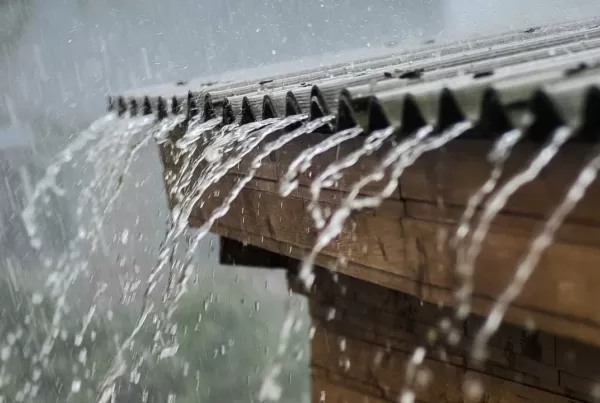A leaked roof can turn a peaceful night into a nightmare, casting a dark cloud over even the most cheerful moods. The sound of water droplets hitting the floor can feel like a constant. Drumbeat, disturbing the peace of the night. The person would wake up feeling groggy, drained, and frustrated as the leak looms over their head like a dark cloud. The leak has ruined their night and left them with a sense of unease and frustration, a reminder of the unpredictability of life and the challenges we face in dealing with them.
If you’ve stumbled upon this article, chances are you’ve experienced the frustration and anxiety of a leaking metal roof. But fear not, for this guide will take you on a journey toward solving this pesky problem.
First, we’ll delve into the nitty-gritty details of metal roof repair, offering tips and tricks to help you tackle the problem with confidence and ease. We’ll also explore the root causes of the leak and help you identify where the issue lies.
We’ll take you step by step through fixing the leak, from assessing the extent of the damage to identifying the tools and materials you’ll need for the job.
Fortunately, fixing a metal roof leak is not as difficult as it may seem. In this article, we’ll take you through the steps you need to follow to fix a metal roof leak, helping you get your roof back to tip-top shape.
Also read: Can you walk on a metal roof
Here’s how to fix a metal roof leak
Step 1: Locate the Leak
The first step in fixing a metal roof leak is to identify the source of the problem. This can be challenging, as the leak’s location may take time to be apparent. However, there are a few signs you can look for that indicate where the leak is coming. These include water stains on the ceiling, damp insulation, mould, and mildew growth.
Once you’ve identified the general location of the leak, you’ll need to climb onto the roof and inspect the area more closely. Look for visible damage, such as cracks, holes, or gaps. These are the most likely culprits for a leak.
Step 2: Clean the Area
Before repairing the leak, you’ll need to clean the area around it. You can use a wire brush to remove rust, dirt, or debris that may be present. This will ensure that the repair material adheres appropriately to the surface.
Step 3: Apply Sealant
The next step is to apply a sealant to the damaged area. You can use several types of sealant, including silicone, urethane, and butyl rubber. The type of sealant you choose will depend on the extent of damage and climate in your area.
Apply the sealant to the damaged area using a putty knife or caulking gun. Be sure to apply enough sealant to cover the entire damaged area. Smooth the sealant with a putty knife to ensure it adheres properly to the surface.
Step 4: Apply a Patch
Sometimes, simply applying sealant may not be enough to fix the leak. If the damage is more extensive, you may need a patch. You’ll need a metal flashing slightly larger than the damaged area to do this.
Place the flashing over the damaged area, ensuring it extends at least two inches beyond the damaged scope in all directions. Use roofing screws to attach the flashing to the roof. Be sure to seal around the edges of the flashing with sealant to ensure it’s watertight.
Step 5: Check for Additional Leaks
Once you’ve applied the sealant and patch, checking the surrounding area for additional leaks is essential. Metal roofs are prone to developing leaks in multiple areas, so it’s essential to be thorough in your inspection.
Use a hose or bucket of water to simulate rainfall and check for any new leaks. If you find additional leaks, repeat the cleaning, sealing, and patching process until all leaks have been addressed.
Also read: Stone Coated Metal Roofing
Step 6: Consider a Professional Inspection
If you need more confidence in your ability to fix the leak on your own, or if the damage is extensive, it’s a good idea to hire a professional metal supplier like 2nd time around to inspect your roof. We can help you identify the leak and recommend the best course of action for fixing it.
Additionally, a professional inspection can help you identify any other problems with your roof that may lead to leaks in the future.
What causes a metal roof leak?
A metal roof is an excellent choice for homeowners looking for a durable, long-lasting roofing solution. However, despite their durability, metal roofs are not immune to leaks. Metal roofs are particularly vulnerable to leaks due to a variety of factors. In this article, we’ll explore the leading causes of metal roof leaks, helping you understand what might be causing your roof to leak and how to fix it.
Improper installation
One of the most common causes of metal roof leaks is improper installation. If you want your metal roof to be installed correctly, try working with a professional roofing contractor with an experience in metal roofing installation will be essential and convenient for your roof. They will ensure that your roof is installed correctly, using the proper materials and techniques to minimize the risk of leaks.
Natural phenomenon
Another cause of metal roof leaks is the natural wear and tear over time. Metal roofs are durable, but they’re not indestructible. Exposure to the elements, including rain, wind, and extreme temperatures, can cause metal roofs to expand and contract, leading to cracks and other damage.
Also, metal roofs can be damaged by falling debris, such as tree branches or hailstones. To prevent this damage, it’s essential to keep an eye on your roof and to have it inspected regularly by a professional roofing contractor.
Design of the roof
The design of your metal roof can also contribute to leaks. For example, if your roof has a low slope, it’s more vulnerable to leaks than a steeper one. This is because water can pool on a low-slope roof, leading to leaks over time.
To avoid this problem, it’s essential to design your roof with proper drainage in mind. Your roofing contractor can help you determine the appropriate slope for your roof and ensure it’s designed to prevent water from pooling.
Foot traffic
Metal roofs can also leak due to damage caused by foot traffic. If your roof is easily accessible, it’s possible that people walking on it can cause damage, such as dents or scratches, which can lead to leaks. Limiting access to your roof as much as possible is essential to avoid this problem. If you must access your roof, use proper safety equipment and avoid walking on areas not designed to support the weight.
Various factors, including improper installation, natural wear and tear, poor design, foot traffic, and improper maintenance, can cause a metal roof leak. Understanding the causes of metal roof leaks can help you identify the problem and take steps to fix it.
Suppose you’re experiencing a metal roof leak. In that case, it’s essential to work with a professional roofing contractor like 2nd time Around, who can assess the extent of the damage and recommend the best course of action. With the right approach, you can keep your metal roof in excellent condition and prevent leaks from causing damage to your home.
Conclusion
Fixing a metal roof leak may seem daunting, but it’s a relatively straightforward process. By following these steps, you can identify the source of the leak, clean the area, apply sealant and a patch, and check for additional leaks. If you’re not comfortable with fixing the leak yourself, don’t hesitate to contact a professional roofing contractor for




